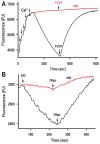Mitochondrial calcium transport in trypanosomes
- PMID: 25218432
- PMCID: PMC4253566
- DOI: 10.1016/j.molbiopara.2014.09.001
Mitochondrial calcium transport in trypanosomes
Abstract
The biochemical peculiarities of trypanosomes were fundamental for the recent molecular identification of the long-sought channel involved in mitochondrial Ca(2+) uptake, the mitochondrial Ca(2+) uniporter or MCU. This discovery led to the finding of numerous regulators of the channel, which form a high molecular weight complex with MCU. Some of these regulators have been bioinformatically identified in trypanosomes, which are the first eukaryotic organisms described for which MCU is essential. In trypanosomes MCU is important for buffering cytosolic Ca(2+) changes and for activation of the bioenergetics of the cells. Future work on this pathway in trypanosomes promises further insight into the biology of these fascinating eukaryotes, as well as the potential for novel target discovery.
Keywords: Acidocalcisome; Calcium; Inositol 1,4,5-trisphosphate receptor; Mitochondrial calcium uniporter.
Copyright © 2014 Elsevier B.V. All rights reserved.
Figures






Similar articles
-
Mitochondrial Ca2+ homeostasis in trypanosomes.Int Rev Cell Mol Biol. 2021;362:261-289. doi: 10.1016/bs.ircmb.2021.01.002. Epub 2021 Feb 27. Int Rev Cell Mol Biol. 2021. PMID: 34253297 Free PMC article. Review.
-
The mitochondrial calcium uniporter complex in trypanosomes.Cell Biol Int. 2018 Jun;42(6):656-663. doi: 10.1002/cbin.10928. Epub 2018 Jan 25. Cell Biol Int. 2018. PMID: 29286188 Free PMC article. Review.
-
The Mitochondrial Ca2+ Uniporter Complex (MCUC) of Trypanosoma brucei Is a Hetero-oligomer That Contains Novel Subunits Essential for Ca2+ Uptake.mBio. 2018 Sep 18;9(5):e01700-18. doi: 10.1128/mBio.01700-18. mBio. 2018. PMID: 30228243 Free PMC article.
-
The Mitochondrial Calcium Uniporter Interacts with Subunit c of the ATP Synthase of Trypanosomes and Humans.mBio. 2020 Mar 17;11(2):e00268-20. doi: 10.1128/mBio.00268-20. mBio. 2020. PMID: 32184243 Free PMC article.
-
MICU1 and MICU2 Play an Essential Role in Mitochondrial Ca2+ Uptake, Growth, and Infectivity of the Human Pathogen Trypanosoma cruzi.mBio. 2019 May 7;10(3):e00348-19. doi: 10.1128/mBio.00348-19. mBio. 2019. PMID: 31064825 Free PMC article.
Cited by
-
Mitochondrial Ca2+ homeostasis in trypanosomes.Int Rev Cell Mol Biol. 2021;362:261-289. doi: 10.1016/bs.ircmb.2021.01.002. Epub 2021 Feb 27. Int Rev Cell Mol Biol. 2021. PMID: 34253297 Free PMC article. Review.
-
The mitochondrial calcium uniporter complex in trypanosomes.Cell Biol Int. 2018 Jun;42(6):656-663. doi: 10.1002/cbin.10928. Epub 2018 Jan 25. Cell Biol Int. 2018. PMID: 29286188 Free PMC article. Review.
-
The binuclear cyclopalladated complex CP2 is targeting ubiquinol-cytochrome c reductase (complex III) of Leishmania amazonensis.Int J Parasitol Drugs Drug Resist. 2025 Apr;27:100574. doi: 10.1016/j.ijpddr.2024.100574. Epub 2024 Dec 19. Int J Parasitol Drugs Drug Resist. 2025. PMID: 39746288 Free PMC article.
-
Membrane Proteins in Trypanosomatids Involved in Ca2+ Homeostasis and Signaling.Genes (Basel). 2018 Jun 19;9(6):304. doi: 10.3390/genes9060304. Genes (Basel). 2018. PMID: 29921754 Free PMC article. Review.
-
Structural characterization of the mitochondrial Ca2+ uniporter provides insights into Ca2+ uptake and regulation.iScience. 2021 Jul 22;24(8):102895. doi: 10.1016/j.isci.2021.102895. eCollection 2021 Aug 20. iScience. 2021. PMID: 34401674 Free PMC article. Review.
References
-
- Sogin ML, Hinkle G, Leipe DD. Universal tree of life. Nature. 1993;362(6423):795. - PubMed
-
- Ziemann H. Eine methode der doppelfärbung bei flagellaten, pilzen, spirillen und bakterien, sowie bei einigen amöben. Zentralbl Bakteriol Parasitenkd Infektionskr Hyg. 1898;24:945–955.
-
- Shlomai J. The structure and replication of kinetoplast DNA. Curr Mol Med. 2004;4(6):623–47. - PubMed
-
- Benne R, Van Den Burg J, Brakenhoff JP, Sloof P, Van Boom JH, et al. Major transcript of the frameshifted cox II gene from trypanosome mitochondria contains four nucleotides that are not encoded in the DNA. Cell. 1986;46(6):819–26. - PubMed
-
- Stuart KD, Schnaufer A, Ernst NL, Panigrahi AK. Complex management: RNA editing in trypanosomes. Trends Biochem Sci. 2005;30(2):97–105. - PubMed
Publication types
MeSH terms
Substances
Grants and funding
LinkOut - more resources
Full Text Sources
Other Literature Sources
Miscellaneous

